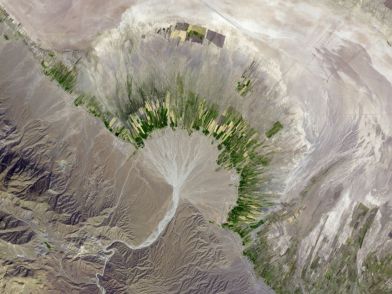An alluvial fan is a triangle-shaped deposit of gravel, sand, and even smaller pieces of sediment, such as silt. This sediment is called alluvium.
Alluvial fans are usually created as flowing water interacts with mountains, hills, or the steep walls of canyons. Streams carrying alluvium can be trickles of rainwater, a fast-moving creek, a powerful river, or even runoff from agriculture or industry. As a stream flows down a hill, it picks up sand  and other particles—alluvium.
and other particles—alluvium.
The rushing water carries alluvium to a flat plain, where the stream leaves its channel to spread out. Alluvium is deposited as the stream fans out, creating the familiar triangle-shaped feature.
The narrow point of the alluvial fan is called its apex, while the wide triangle is the fan’s apron. Alluvial fans can be tiny, with an apron of just a few centimeters spreading out from the trickle of a drainpipe. They can also be enormous. Over time, water flowing down the Koshi River in Nepal, for example, has built up an alluvial fan more than 15,000 square kilometers (almost 5,800 square miles) wide. This “megafan” carries alluvium from the Himalaya Mountains.
Types of Alluvial Fans
Bajada
A bajada is the convergence, or of many alluvial fans. Bajadas are common in dry climates, such as the canyons of the American Southwest. Bajadas can be narrow, from the flow of two or three streams of water, or they can be wide, where dozens of alluvial fans converge.
Alluvial fans and bajadas are often found in deserts, where flash floods wash alluvium down from nearby hills. They can also be found in wetter climates, where streams are more common.
Underwater Fans
Alluvial fans are even found underwater. An underwater fan is created as an underwater current deposits alluvium from a submarine hill or glacier.
Formed Without Water
Sometimes, fans are formed without the aid of water. These are called colluvial fans. Colluvial fans are created by mass wasting. Mass Wasting is is the downward movement of rock, soil, or other material. Alluvium is material transported by water, while colluvium is material transported by mass wasting. Landslides are an instance of mass wasting that often create colluvial fans.
Debris Cone
A debris cone is a type of alluvial fan with a steep slope, closer to the shape of a half-cone than a flat fan. Debris cones can be created by the slow accumulation of alluvium over many centuries. They can also form as boulders and other large materials gather during landslides, floods, or other instances of mass wasting.
Alluvial fans can be very diverse habitats. Shrubs such as rabbitbrush and greasewood, or even trees such as ash or willow, are common in the area of alluvial fans. These plants have very deep roots, which can access the water that helped create the alluvial fan, but has now sunken far below it.
Creating a settlement on an alluvial fan can be dangerous. Alluvial fans are prone to flooding. Rushing water, mud, and debris can threaten communities many kilometers away from the apex of the alluvial fan.
Extraterrestrial Alluvium
Alluvial fans exist on other planets. The presence of alluvial fans on Mars gives evidence for the existence of liquid water on the planet billions of years ago.
Source(s)
Wikipedia
national Geographic Society Site
